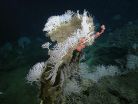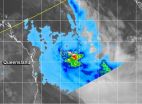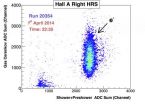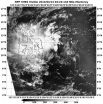(Press-News.org) MOSS LANDING, CA — Killer sponges sound like creatures from a B-grade horror movie. In fact, they thrive in the lightless depths of the deep sea. Scientists first discovered that some sponges are carnivorous about 20 years ago. Since then only seven carnivorous species have been found in all of the northeastern Pacific. A new paper authored by MBARI marine biologist Lonny Lundsten and two Canadian researchers describes four new species of carnivorous sponges living on the deep seafloor, from the Pacific Northwest to Baja California.
A far cry from your basic kitchen sponge, these animals look more like bare twigs or small shrubs covered with tiny hairs. But the hairs consist of tightly packed bundles of microscopic hooks that trap small animals such as shrimp-like amphipods. Once an animal becomes trapped, it takes only a few hours for sponge cells to begin engulfing and digesting it. After several days, all that is left is an empty shell.
MBARI researchers videotaped the new sponges on the seafloor, then collected a few samples for taxonomic work and species-reference collections. Back in the lab, when they looked closely at the collected sponges, the scientists discovered, as Lundsten put it, "numerous crustacean prey in various states of decomposition."
Sponges are generally filter feeders, living off of bacteria and single-celled organisms sieved from the surrounding water. They contain specialized cells called choancytes, whose whip-like tails move continuously to create a flow of water which brings food to the sponge. However, most carnivorous sponges have no choancytes. As Lundsten explained, "To keep beating the whip-like tails of the choancytes takes a lot of energy. And food is hard to come by in the deep sea. So these sponges trap larger, more nutrient-dense organisms, like crustaceans, using beautiful and intricate microscopic hooks."
The spikiness of two these new sponges is reflected in the name of their genus—Asbestopluma. One of these, Asbestopluma monticola was first collected from the top of Davidson Seamount, an extinct underwater volcano off the Central California coast (monticola means "mountain-dweller" in Latin).
A second new species, Asbestopluma rickettsi, was named after marine biologist Ed Ricketts, who was immortalized in John Steinbeck's book, Cannery Row. This sponge was observed at two locations offshore of Southern California. At one of these spots, the sponge was living near colonies of clams and tubeworms that use bacteria to obtain nutrition from methane (natural gas) seeping out of the seafloor. Although A. rickettsi has spines, the researchers did not see any animals trapped on the specimens they collected. Ongoing research suggests that this sponge, like its "chemosynthetic" neighbors, can use methane-loving bacteria as a food source.
The third and fourth new species of carnivorous sponges were also observed near communities of chemosynthetic animals. However these communities were associated with deep-sea hydrothermal vents, where plumes of hot, mineral-rich water flow out of the seafloor.
One new species, Cladorhiza caillieti, was found on recent lava flows along the Juan de Fuca Ridge, a volcanic ridge offshore of Vancouver Island. The fourth sponge, Cladorhiza evae, was discovered far to the south, in a newly discovered hydrothermal vent field on the Alarcon Rise, off the tip of Baja California. Specimens of both these sponges had numerous prey trapped among their spines.
Although it's clear that the sponges with trapped animals were consuming their crustacean prey, the authors are looking forward to the day when they will actually get to see this process in action. Until then, horror-movie fans will have plenty to look forward to—as Lundsten and his coauthors noted in their recent paper, "Numerous additional carnivorous sponges from the Northeast Pacific (which have been seen and collected by the authors) await description, and many more, likely, await discovery."
INFORMATION:
Link to on-line version of news release:
http://www.mbari.org/news/news_releases/2014/killersponges/killersponges-release.html
Link to images associated with this news release:
http://www.mbari.org/news/news_releases/2014/killersponges/killersponges-images.html
MBARI YouTube Video about this release:
http://www.youtube.com/watch?list=PL8y7x0SoYxpdwG4G6XN-Yzb6rBVU2pK8W&feature=player_detailpage&v=oJeyOU4eSKw
Researchers describe 4 new species of 'killer sponges' from the deep sea
2014-04-14
ELSE PRESS RELEASES FROM THIS DATE:
Babies prefer fairness -- but only if it benefits them -- in choosing a playmate
2014-04-14
A couple of years ago a University of Washington researcher who studies how children develop social behaviors like kindness and generosity noticed something odd. The 15-month-old infants in her experiments seemed to be playing favorites among the researchers on her team, being more inclined to share toys or play with some researchers than others.
"It's not like one experimenter was nicer or friendlier to the babies – we control for factors like that," said Jessica Sommerville, a UW associate professor of psychology. She took a closer look at the data and realized that ...
NASA sees Tropical Cyclone Ita over the Coral Sea
2014-04-14
Tropical Cyclone Ita made landfall in northeastern Queensland, Australia on April 11 as a powerful Category 4 hurricane on the Saffir-Simpson scale, moved south and re-emerged in the Coral Sea on April 14 where NASA's TRMM and NASA-NOAA's Suomi NPP Satellites captured imagery of the weakened storm.
The VIIRS instrument aboard NASA-NOAA's Suomi NPP satellite captured a visible look at Ita's elongating structure on April 14 at 4:12 UTC/12:12. The Visible Infrared Imaging Radiometer Suite (VIIRS) instrument collects visible and infrared imagery and global observations of ...
Website information on colon cancer too complex, fails to address key concerns
2014-04-14
DALLAS – April 14, 2014 – Popular web information on colorectal cancer is too difficult for most lay people to read and doesn't address the appropriate risks to and concerns of patients, a study by UT Southwestern Medical Center gastroenterologists suggests.
In a review of a dozen popular websites, most of the online patient education materials for colorectal cancer screening were written beyond the recommended sixth-grade reading level, while content on the sites failed to address key risks, as well as the barriers to and benefits of screening, according to the study's ...
Beam on target!
2014-04-14
Late on April 1, the crown jewel of the Department of Energy's Thomas Jefferson National Accelerator Facility ("Jefferson Lab") sparkled its way into a new era. Following an upgrade of the Continuous Electron Beam Accelerator Facility, the CEBAF accelerator delivered the highest-energy electron beams it has ever produced into a target in an experimental hall, recording the first data of the 12 GeV era. The machine sent electrons around the racetrack three times (known as "3-pass" beam), resulting in 6.11 GeV electrons at 2 nanoAmps average current for more than an hour.
"This ...
NASA sees remnants of Tropical Depression Peipah over Southern Philippines
2014-04-14
Tropical Depression Peipah has been very stubborn and has moved over the southern and central Philippines bringing clouds, showers and gusty winds. NASA-NOAA's Suomi NPP satellite captured an image that showed Peipah's clouds covering the Visayas and Mindanao regions of the country.
The VIIRS instrument aboard NASA-NOAA's Suomi NPP satellite captured a visible look at the remnant clouds associated with former Tropical Depression Peipah on April 14 at 4:24 UTC/12:24 a.m. EDT. The Visible Infrared Imaging Radiometer Suite (VIIRS) instrument collects visible and infrared ...
Pharmacists can significantly improve blood pressure, cholesterol in stroke patients
2014-04-14
Stroke patients managed by a pharmacist had a 12.5% improvement in blood pressure and low-density lipoprotein (LDL), or "bad" cholesterol levels compared with a control group, according to a clinical trial published in CMAJ (Canadian Medical Association Journal).
Patients who have a stroke or "mini stroke" (transient ischemic attack) are at high risk of adverse cardiovascular events. Management of high blood pressure and cholesterol after a stroke is important because it can substantially reduce the risk of a negative event; however, many patients receive suboptimal care. ...
'MicroRNA' could be key target for bowel cancer treatment
2014-04-14
Scientists found that the molecule, called microRNA 135b, is a vital 'worker' employed by several important cancer genes to drive the growth of bowel cancers.
Drugs targeted at the microRNA could knock out the effects of multiple cancer-causing mutations at once, while tests for it could identify patients with the most aggressive disease, the researchers believe.
The research was carried out by an international team including scientists based at The Institute of Cancer Research, London, the University of Glasgow and Ohio State University in the US.
Scientists tested ...
Study identifies a likely key driver of colorectal cancer development and progression
2014-04-14
COLUMBUS, Ohio – A new study identifies a molecule that is a probable driving force in colorectal cancer and suggests that the molecule could be an important target for colorectal cancer treatment and a valuable biomarker of tumor progression.
The study of microRNA-135b (miR-135b) in two animal models and human tumors was published in the journal Cancer Cell and was led by researchers at The Ohio State University Comprehensive Cancer Center – Arthur G. James Cancer Hospital and Richard J. Solove Research Institute (OSUCCC – James) and at the University of Glasgow in ...
Dietary supplement use among US adults more prevalent than previously thought
2014-04-14
Washington, D.C., April 14, 2014—Dietary supplement use by U.S. adults is more prevalent than indicated by published data from the National Health and Nutrition Examination Surveys (NHANES), according to a new article in the peer-reviewed Journal of the American College of Nutrition (JACN). The review article is based on five consecutive years of online market research studies, conducted by Ipsos Public Affairs for the Council for Responsible Nutrition (CRN).
According to Annette Dickinson, Ph.D., corresponding author and a consultant for CRN, "This new review adds to ...
Young dads at high risk of depression, too
2014-04-14
CHICAGO --- Depression can hit young fathers hard -- with symptoms increasing dramatically during some of the most important years of their children's lives, a new Northwestern Medicine® study has found.
Depressive symptoms increased on average by 68 percent over the first five years of fatherhood for these young men, who were around 25 years old when they became fathers and whom lived in the same home as their children. The results of the study were published April 14 in the journal Pediatrics.
This study is the first to identify when young fathers are at increased ...





